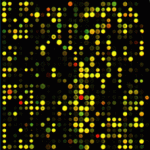Genomics
|
23 april 2014 10:46:25 |
| Transcriptome assembly and microarray construction for Enchytraeus crypticus, a model oligochaete to assess stress response mechanisms derived from soil conditions (BMC Genomics) |
|
Tweet Background:
The soil worm Enchytraeus crypticus (Oligochaeta) is an ecotoxicology model species that, until now, was without genome or transcriptome sequence information. The present research aims at studying the transcriptome of Enchytraeus crypticus, sampled from multiple test conditions, and the construction of a high-density microarray for functional genomic studies.
Results:
Over 1.5 million cDNA sequence reads were obtained representing 645 million nucleotides. After assembly, 27,296 contigs and 87,686 singletons were obtained, from which 44% and 25% are annotated as protein-coding genes, respectively, sharing homology with other animal proteomes. Concerning assembly quality, 84% of the contig sequences contain an open reading frame with a start codon while E. crypticus homologs were identified for 92% of the core eukaryotic genes. Moreover, 65% and 77% of the singletons and contigs without known homologs, respectively, were shown to be transcribed in an independent microarray experiment. An Agilent 180 K microarray platform was designed and validated by hybridizing cDNA from 4 day zinc- exposed E. crypticus to the concentration corresponding to 50% reduction in reproduction after three weeks (EC50). Overall, 70% of all probes signaled expression above background levels(mean signal + 1x standard deviation). More specifically, the probes derived from contigs showed a wider range of average intensities when compared to probes derived from singletons. In total, 522 significantly differentially regulated transcripts were identified upon zinc exposure. Several significantly regulated genes exerted predicted functions (e.g. zinc efflux, zinc transport) associated with zinc stress. Unexpectedly, the microarray data suggest that zinc exposure alters retro transposon activity in the E. crypticus genome.
Conclusion:
An initial investigation of the E. crypticus transcriptome including an associated microarray platform for future studies proves to be a valuable resource to investigate functional genomics mechanisms of toxicity in soil environments and to annotate a potentially large number of lineage specific genes that are responsive to environmental stress conditions. |
| 99 viewsCategory: Genomics |
 Identification and characterization of transcript polymorphisms in soybean lines varying in oil composition and content (BMC Genomics) Identification and characterization of transcript polymorphisms in soybean lines varying in oil composition and content (BMC Genomics)MKL1/2 and ELK4 co-regulate distinct serum response factor (SRF) transcription programs in macrophages (BMC Genomics) 
|
| blog comments powered by Disqus |
MyJournals.org
The latest issues of all your favorite science journals on one page
The latest issues of all your favorite science journals on one page



